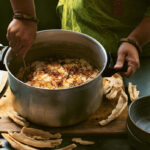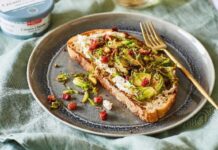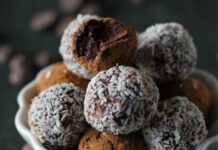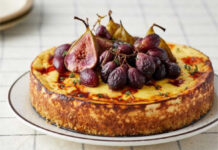“Biryani was always made for big celebratory occasions,” says chef Asma Khan, author of Ammu – a cookbook dedicated to her mother.
“This is also usually the last dish I eat at home before I make the five-hour car journey from my parents’ home to the airport to catch my flight to London. I always felt that layered in that biryani were things my mother couldn’t say. When the biryani arrived on the table, it felt like Ammu’s secret code, telling me that she loved me.”

Chicken biryani
Equipment
- Bowls
- heavy-based pan
- Large pan
Ingredients
- 200 g plain flour
- 500 g good-quality basmati rice
- 5 tbsp salt
- ½ tsp saffron strands
- 80 ml full-fat milk
- 8 tbsp ghee or vegetable oil (sometimes I mix both and it works really well)
- 2 white onions thinly sliced into half moons
- 1 kg skinless chicken thighs on the bone
- 3 garlic cloves crushed
- 5-6 cm piece of fresh ginger grated
- 2 tbsp full-fat Greek-style yoghurt
- ½ tsp chilli powder
- 2 green cardamom pods
- 2 cloves
- 1 cm piece of cinnamon stick
- 1 cm piece of mace crushed
- ⅛ tsp grated nutmeg
- ¼ tsp sugar
- ½ lemon juice
Method
- Mix the flour with enough water to make a firm dough, cover and leave to rest.
- Wash the rice in a bowl of cold water, moving your hand in gentle circular movements in one direction to avoid breaking the delicate tips of the rice (the virtually invisible tips, if broken off, will boil rapidly when the rice goes into the hot water, because of their size, and turn into glue-like starch, which will make all the rice sticky).
- Wash the rice in several changes of cold water until the water remains clear. Next, soak the rice. There should be at least 15–20cm of water in the bowl above the rice level. Add six teaspoons of the salt and soak the rice for at least two hours. The long soaking allows the rice to absorb water. As the rice is not hollow and dry when it is put into boiling water, the cooking time is minimised; this will help keep your rice grains long and separate.
- Put the saffron in a small bowl. Warm the milk to tepid: my mother would describe it as blood temperature – if you touch the milk it should feel only slightly warm. If you are using a microwave to heat the milk, remember to stir the milk before checking the temperature as there may be hot spots. Pour the tepid milk over the saffron and set aside to infuse.
- Heat the ghee or oil in a heavy-based pan over a medium-high heat and fry the onions until caramelised. Using a slotted spoon and leaving as much of the oil in the pan as possible, remove the onions to a plate, spreading them across the plate to cool.
- Remove half the oil from the pan and set aside. In the remaining oil add the chicken and cook over a medium-high heat until golden brown on both sides. Add the garlic, ginger, yoghurt, chilli powder and two teaspoons of the salt and cook over a medium-high heat until the garlic and ginger have lost their raw smell and the yoghurt has reduced. Add half the caramelised onions, then add warm water to cover the chicken, bring to the boil, then cover and simmer for about 25 minutes. You do not want the chicken to be tender: it should still be firm, as it will be cooked further with the rice.
- Drain the soaked rice. Boil the kettle and pour the water into a large pan. Bring back to the boil, add another six teaspoons salt, then add the drained rice and boil until the rice is three-quarters cooked (this should not take more than five minutes). To test, remove one grain from the boiling water and squeeze it. There should be a hard core to the grain of rice. When the rice reaches this stage, drain and spread it on a tray to prevent it from continuing to cook.
- To assemble the biryani you will need a heavy-based pan with a tight-fitting lid. Using a slotted spoon, remove the chicken from its cooking liquid and place it in the pan. Strain the cooking liquid and pour over the chicken. Try to squeeze as much as you can from the onion/ginger/garlic residue, so the stock is nice and thick. It should just about cover the chicken pieces. Next, add the cardamom, cloves, cinnamon, mace and nutmeg. Add half the saffron milk, the sugar and squeezed lemon juice. Then add the rice, ensuring it covers the chicken. On top of the rice add the remaining caramelised onions, the remaining saffron milk and the reserved oil.
- Put the biryani pan over a high heat and wait until the steam starts coming out. Let the steam come through for one minute. Meanwhile, roll the dough into tubes and use the dough to seal the lid of the biryani pan. Put the pan on top of an iron frying pan or tawa over a medium-high heat: this is to diffuse the heat. If you do not have an iron pan, put the biryani into a preheated oven at 190°C for 10 minutes. After 10 minutes, turn the oven to 150°C and leave for 20 minutes. If you are using a tawa on the hob, reduce the heat to low, cover the top of the pan with a folded clean kitchen cloth and leave for 20 minutes.
- When ready to serve, unseal the biryani lid. Using a large spoon and starting from one side, gently lift the chicken up and mix with the rice. You need to gently merge the wet rice with the dry rice on top, so each grain is perfectly moist.
Nutrition
Ammu: Indian Home-Cooking To Nourish Your Soul by Asma Khan is published by Ebury Press. Photography by Laura Edwards.
- Amazon Kindle Edition
- Khan, Asma (Author)
- English (Publication Language)
Last update on 2024-04-26 / Affiliate links / Images from Amazon Product Advertising API
Best-selling heavy-based pans
Need a pan for this recipe? Check out our list of best-selling heavy-based pans on Amazon.
No products found.
You may be interested in…
This article may include affiliate links to products and services where we may receive a small fee to support the running of this site if you make a purchase or is a sponsored article from one of our select editorial partners providing valuable advice and information to our readers.

































































